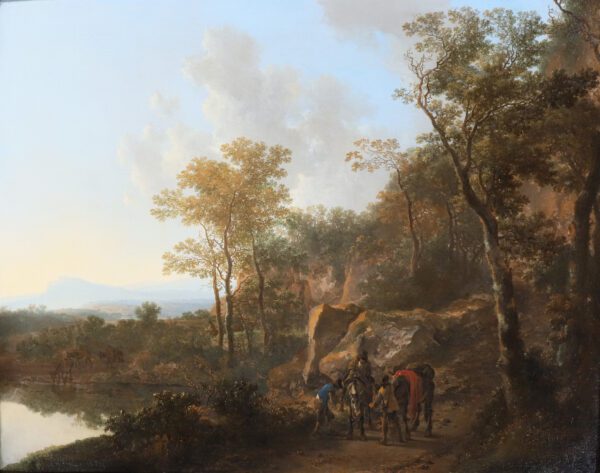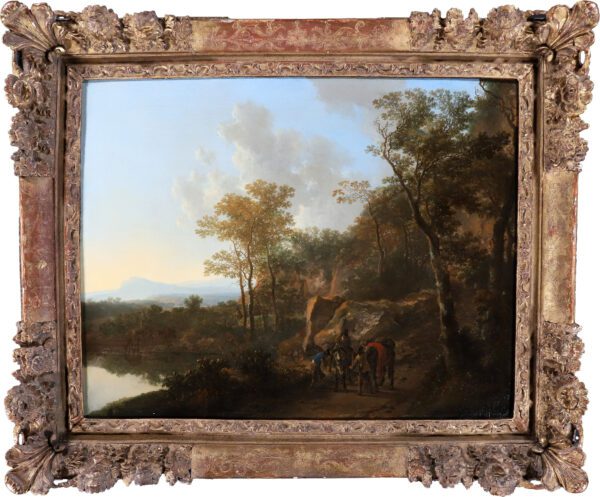“An Italianate landscape with a forest and figures on horseback”
Oil on canvas: 60 x 80 cm
"*" indicates required fields
Notes
Jan Both was the main pioneer of Italianate landscape in 17th-century Holland. He introduced to Dutch landscape a style based on the work of Claude Lorraine in Rome. His Italianate landscape style was developed by such painters as Nicolaes Berchem in Haarlem. It also influenced the development of Albert Cuyp.
Jan Both was one of the foremost painters of the second generation of Dutch Italianates. In the 17th century, Dutch artists travelled in large numbers to Italy, an important destination for studying the art of antiquity, the Renaissance, and their own time. Those who crossed the Alps are known as Dutch Italianates. Once in Rome, many of them joined the Bentvueghels, a brotherhood of mainly Dutch and Flemish artists that was founded in 1620. In their work they primarily focused on Rome and the surrounding countryside. Artists like Bartholomeus Breenbergh, Jan Asselijn, and Herman van Swanevelt endeavoured to capture the unique golden glow of Italian light.
Jan was the younger brother of Andries Both (1611/12–1642), who was also a landscape painter, and with whom he collaborated. Jan is said to have studied with his father, Dirk Both, a glass painter, and possibly with the history painter and landscapist Abraham Bloemaert (1566–1651). According to the 17th-century German biographer Sandrart he also trained in Utrecht with the history painter and portraitist Gerrit van Honthorst (1592–1656) between 1634 and 1637, but his early works show that he was particularly influenced by the Italianate landscapes of Chaerles de Hooch (c. 1577–1638), who also lived in Utrecht.
Some time after 1637 Both travelled to Rome to join his brother Andries, and became friends with Herman van Swanevelt (1603–55) and Claude Lorrain (1604/5–82). The four of them contributed to a series of landscapes for the Buen Retiro Palace in Madrid (now in the Prado). Jan Both specialized in idealized landscapes, with figures inspired by those of Pieter van Laer (1599–1642). In 1642 he and his brother set out to return to the Netherlands; on the way, Andries drowned in Venice.
The first evidence of Jan’s presence back in the Netherlands is a drawing of a Dutch landscape dated 1643 (National Museum, Budapest). The earliest documents of his reappearance in Utrecht are dated 1646 and 1649, the latter date marking his appointment as overman in the Utrecht painters’ guild. From this point on he concentrated on wooded landscapes, characterized by golden light and minute detail – idealized visions of the Roman countryside and the mountains of the Apennines, none depicting an identifiable place. Only one of Both’s landscapes from his post-Italian period is dated. An attempt has been made to place them in chronological order by comparing them with dated works by Herman Saftleven II (c. 1609–85), who used Both’s compositions as starting points.
Both often collaborated with other artists. In addition to Claude, he worked with his brother Andries, and with Nicholas Knüpfer (c. 1609–55), Cornelis van Poelenburch (1594–1667), Jan Baptist Weenix (1621–59), and Pieter Saenredam (1597–1665). In Rome, the figures in Jan’s paintings were probably contributed by Andries and other artists. In the early literature Andries is always mentioned as collaborator – even in paintings made after his brother’s death in 1642.
Jan Both had a strong influence on Nicolaes Berchem (1621/2–1683), Aelbert Cuyp (1620–91) and Adam Pijnacker (1620/21–73), as well as on the third generation of Dutch Italianates, who were particularly impressed by his Apennine scenes. In the 18th and early 19th centuries he was widely admired by collectors; his work was included in the famous œuvre catalogues by John Smith (vol. vi, 1835).
He rarely dated his works, and they can be difficult to place exactly. Like the Italianate landscapes of Cuyp, Both’s works were prized by Dutch patricians, who preferred them to the native Dutch landscapes in the manner of Jan van Goyen.
Exhibition
- British Institute, London, 1866, no. 83
- Royal Academy, London, 1890, no 112
- Tokyo, Kosama, Kumanoto, De Lakenhal 1992/1993, ‘Inspired by Italy, Dutch landscape painting 1600-1700’, no 19 (L.B. Harwood, Christoph Brown, A. Ch. Steland)
- Dulwich Picture Gallery, UK, 22 May – 26 August, 2002.
Provenance
- Collection Sir Harvey, Bruce, Bart. His sale:
- Christie’s London, 29 June 1849, lot 88.
- Collection Fordham (1849-87), probably his sale:
- Christie’s London
- Collection Alexander Baing 4th Baron Ash Burton, Bath House, Picadilly 1890
- By descent to his son the 5th Earl of Ash Burton, The Grange.
- Alres Fone Hampshire, his sale at The Grange, 1907
- Private collection , United Kingdom
- Sotheby’s, London, 7 december 1988, lot 94
- Whitfield Art, London, 2012
- Bought at TEFAF Maastricht by the current owner, private collection, The Netherlands.
Literature
- Hofstede de Groot, Volume 9, no. 154
Museums with Jan Both paintings in their collection include (amongst others):
Rijksmuseum, Amsterdam
Mauritshuis Royal Picture Gallery, The Hague
Fitzwilliam Museum, Cambridge, UK.
Hermitage, St. Petersburg
Louvre, Paris
Kunsthistorisches Museum, Vienna
Museum of Fine Arts, Boston, USA
National Gallery of Art, Washington D.C.
National Gallery, London
Royal Collection, London
Ashmolean Museum, Oxford
Courtauld Institute of Art, London
Dulwich Picture Gallery, London
National Museum of Western Art, Tokyo
Prado Museum, Madrid
The Wallace Collection, London
Vejle Kunstmuseum, Denmark





